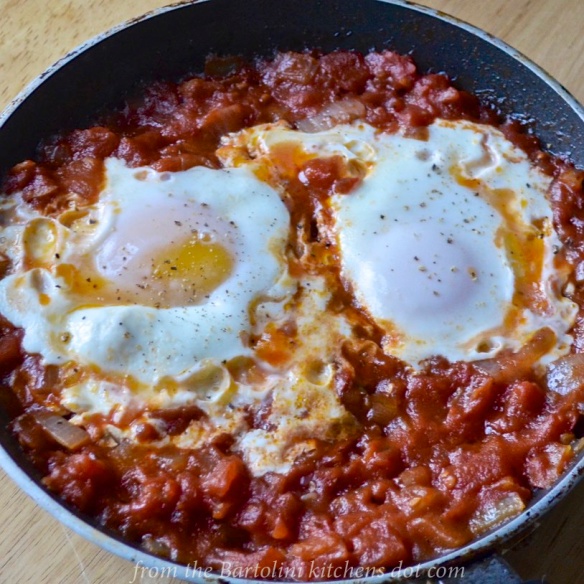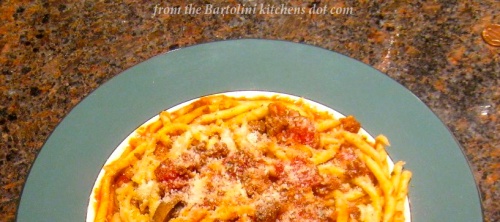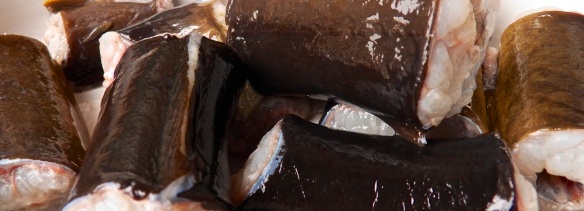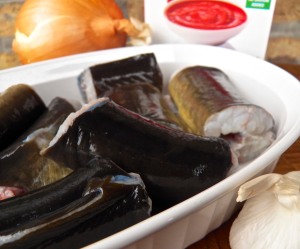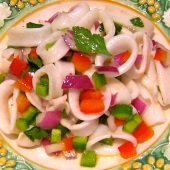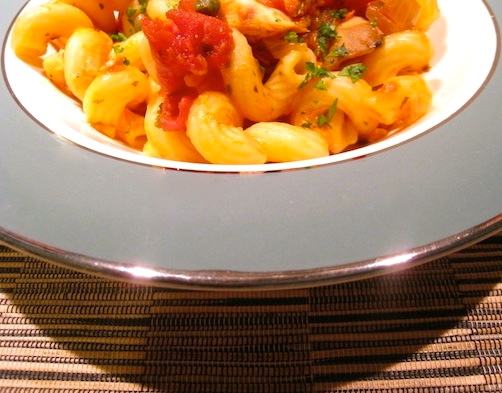Uova in Purgatorio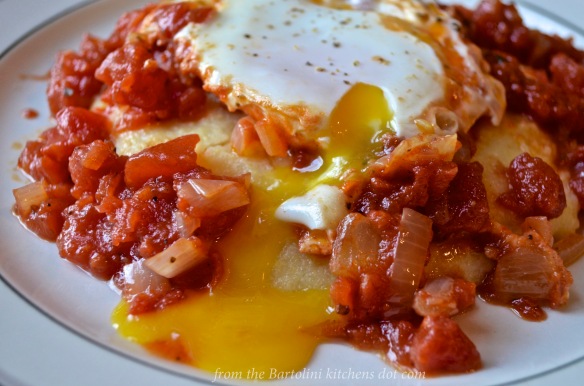 Hello? Is anybody there?
Hello? Is anybody there?
Hmmm. Let me see. Let me see. When last I left you, it was at the height of the holiday season, with Christmas but a day away. And then … well … we’ll get there in a few. Promise.
Today’s dish and recipe have certainly made the rounds. In fact, I’ve seen it so many times that I believed that I must have posted it, as well. That was the case when I read Nell’s delicious recipe last November. Hers is a North African (Tunisian) version called Shakshuka, and you can read all about it HERE.
Not long after, I was in Michigan for my last visit of the year with Zia. I offered to make us an early lunch because her son, the Max Whisperer, planned on leaving at noon. I prepared Eggs in Purgatory for us and served it over toast, as seen in the photo below. At the time, I mentioned that if he would like to make the dish for his wife, he could find the recipe on this blog. Later, I went looking for the recipe and discovered I’d never posted one. It was soon scheduled for the New Year’s post, since many consider this dish a hang-over cure.
As luck would have it, shortly after that another version of the dish was posted on My Arab Life, a blog I’ve begun following relatively recently. Although A.K.’s post didn’t include the recipe for his Shakshuka, he does mention that he included garbanzos, making it a much heartier dish.
Well, things were going rather swimmingly until a few days after Christmas. What started as a mild sore throat soon blossomed into a full-blown case of the flu, proving that this year’s flu vaccine wasn’t worth the sore arm. By any standard of measurement, I was knocked on my arse. And like the most obnoxious of guests, it flat-out refused to leave. Each and every time I thought I’d turned the corner, it was waiting for me and came roaring back with a vengeance.
* * *
Don’t answer the doorbell when taking photos or your Eggs in Purgatory will look like Hell.
* * *
I set up camp in my living room, which offers a view of much of my home. One doesn’t want to let Max out of your sight for too long, regardless of the circumstances. As it turned out, Max was quite the nursemaid. Granted, he’s no Boo Nanny but he did step it up. Each morning, with a reliability that would shame most alarm clocks, Max woke me at 7:00 AM. It’s his breakfast time, you see, and he saw no reason for it to be late. After that, every few hours, he would come check on me to see if all was well. Sometimes he brought me a toy — remnants of an old sock he had liberated from the laundry basket some time ago — and if I was lucky, it was almost dry. At end-of-day, upon re-entering my home after a final trip to the backyard for “last call,” Max would “go left” to my bedroom and I “right” to the sofa. Soon we were both sound asleep. Well one of us was, anyway, for it wasn’t long before the still of the night was broken by the not so melodic rumble of Max snoring in my bed.
At long last, the bug finally departed for points unknown, leaving me exhausted. It took me a while to get back to normal, such at it is, where I have happily remained ever since. Unfortunately, while I was “out”, I did absolutely nothing with this blog until Monday, when I finally started to clear the backlog of just under 6000 notifications. Sad to say, my other email accounts aren’t in much better shape. All in good time …
Thank you for your emails and messages of concern. I hope that I’ve answered them all but fear I may have missed a couple. Thanks, too, for your understanding and patience. I guess all that’s left is to announce that the Kitchens are now open!
We’ll talk about a planned hiatus at another time.
* * *
Eggs in Purgatory is a ridiculously easy dish to make and serve. It can be prepared in under a half-hour and served for breakfast, lunch, or dinner. You can make it as spicy as you like, though when used as a hang-over cure, most like the heat factor raised a notch or two. Here, I’ve written the recipe using 2 eggs. You can easily double or triple the ingredients depending upon the number of people seated at the table. (See Notes)
* * *
* * *
Eggs in Purgatory Recipe
Ingredients
- 2 tbsp olive oil
- 1 small onion, chopped
- 1 small clove garlic, minced or grated
- red pepper flakes, to taste
- 1 can (14.5 oz, 411 g) diced tomatoes (See Notes)
- marjoram to taste
- 2 large eggs
- salt and pepper
- grated Pecorino Romano cheese for garnish
Directions
- In a small fry pan with a lid, heat the olive oil over med-high heat.
- Add the onions, season with salt and pepper, and sauté until translucent, about 6 minutes.
- Add the garlic and red pepper flakes, continue to sauté for about another minute.
- Add the tomatoes and marjoram, stir, and bring to a boil before reducing to a soft simmer.
- Simmer until the sauce is cooked to your satisfaction. Additional water may be added if the sauce is too dry. Taste to check for seasoning.
- Use the back of a ladle or spoon to make a small indentation in the sauce. Fill each with a freshly cracked egg.
- Lightly season the eggs with a bit of salt and pepper, cover, and cook until the eggs are done with the yolks still runny. Alternately, you can place the pan, uncovered, in a pre-heated 375˚ F (190˚ C) oven until the eggs are cooked, about 10 minutes.
- Serve immediately as-is or atop a slice of Italian bread, garnished with some grated cheese and anything else you may like. (See Notes)
* * *
* * *
Notes
As you can see, the dish uses a simple tomato sauce to cook the eggs. There is certainly no need to follow my sauce recipe and you can add whatever else you like, according to your own tastes. In fact, you may have a store-bought sauce that you enjoy and it can easily be used here.
If you like things really hot, you may wish to downgrade your dish from Purgatory to Hell. A little harissa added to the tomato sauce is sure to do the trick.
As a rule of thumb, I use one small can of diced tomatoes (14.5 oz, 411 g) for every 2 eggs being prepared. This will ensure that each egg is served on a nice bed of tomato sauce.
In the past, I always served my eggs as-is or atop sliced Italian bread, sometimes toasted. Nell, however, mentioned serving her eggs atop pasta. Oh, happy day! This is a wonderful variation which soon led to my serving them with polenta, as pictured at the top of this post. If gluten is an issue, however, choose your “platform” wisely.
Although I forgot to do so for the photos, I usually garnish the dish with a bit of grated cheese, though chopped parsley and/or scallions may also be used.
* * *
It’s déjà vu all over again …
This time of year, when it’s far too cold to leave the house for just about any reason, I tend to stay put and go through my arsenal of home-made pasta recipes, looking for one that will occupy my afternoon. Strozzapreti is certainly worth considering. Start up a pot of tomato sauce, make some pasta dough, and get to work making these “priest chokers.” Soon you’ll be enjoying a dish of pure Italian comfort food, completely oblivious to the frigid temperatures just outside your door. You can learn how to make this pasta, and the tale behind its name, simply by clicking HERE.
* * *
Coming soon to a monitor near you …
Agnolotti Redux
* * *

